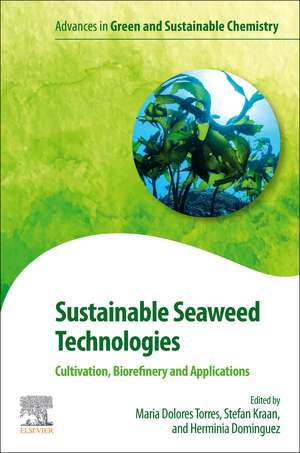Sustainable Seaweed Technologies: Cultivation, Biorefinery, and Applications: Advances in Green and Sustainable Chemistry
Editat de Maria Dolores Torres, Stefan Kraan, Herminia Dominguezen Limba Engleză Paperback – 20 mai 2020
Drawing on the expert knowledge of a global team of editors and authors, this book is a practical resource for both researchers and businesses who currently work with macroalgae.
- Highlights the specific challenges and benefits of developing seaweed for sustainable products
- Presents useful case studies that demonstrate varied approaches and methodologies in practice
- Covers the complete seaweed chain, from cultivation to waste management
Din seria Advances in Green and Sustainable Chemistry
- 18%
 Preț: 612.34 lei
Preț: 612.34 lei - 23%
 Preț: 1061.05 lei
Preț: 1061.05 lei - 24%
 Preț: 1016.00 lei
Preț: 1016.00 lei - 24%
 Preț: 955.40 lei
Preț: 955.40 lei - 24%
 Preț: 959.95 lei
Preț: 959.95 lei - 24%
 Preț: 960.65 lei
Preț: 960.65 lei - 24%
 Preț: 1128.47 lei
Preț: 1128.47 lei - 24%
 Preț: 1016.87 lei
Preț: 1016.87 lei - 24%
 Preț: 1017.40 lei
Preț: 1017.40 lei - 24%
 Preț: 895.87 lei
Preț: 895.87 lei - 24%
 Preț: 898.37 lei
Preț: 898.37 lei - 27%
 Preț: 1102.07 lei
Preț: 1102.07 lei - 23%
 Preț: 912.98 lei
Preț: 912.98 lei - 23%
 Preț: 911.60 lei
Preț: 911.60 lei - 24%
 Preț: 1138.05 lei
Preț: 1138.05 lei - 24%
 Preț: 1013.86 lei
Preț: 1013.86 lei - 27%
 Preț: 1167.21 lei
Preț: 1167.21 lei - 22%
 Preț: 918.17 lei
Preț: 918.17 lei - 24%
 Preț: 904.91 lei
Preț: 904.91 lei - 23%
 Preț: 910.39 lei
Preț: 910.39 lei - 9%
 Preț: 898.73 lei
Preț: 898.73 lei
Preț: 1142.64 lei
Preț vechi: 1494.30 lei
-24% Nou
Puncte Express: 1714
Preț estimativ în valută:
218.71€ • 237.65$ • 183.84£
218.71€ • 237.65$ • 183.84£
Carte tipărită la comandă
Livrare economică 14-28 aprilie
Preluare comenzi: 021 569.72.76
Specificații
ISBN-13: 9780128179437
ISBN-10: 0128179430
Pagini: 750
Dimensiuni: 152 x 229 mm
Greutate: 0.99 kg
Editura: ELSEVIER SCIENCE
Seria Advances in Green and Sustainable Chemistry
ISBN-10: 0128179430
Pagini: 750
Dimensiuni: 152 x 229 mm
Greutate: 0.99 kg
Editura: ELSEVIER SCIENCE
Seria Advances in Green and Sustainable Chemistry
Public țintă
Researchers across academia and industry interested in sustainability, seaweed cultivation, macroalgae, greener chemistry, biofuels, pharmaceuticals, functional foods, nutraceuticals, cosmetics and cosmeceuticals and novel materialsCuprins
Part 1: Introduction to Seaweed and Seaweed Biorefinery
1. Opportunities for seaweed biorefinery
2. Seaweed components, properties, and applications
3. Seaweed resources, collection, and cultivation with respect to sustainability
4. Time for applications of biostimulants in phyconomy: Seaweed Extracts for Enhanced Cultivation of Seaweeds (SEECS)
Part 2: Conditioning and Modification of Seaweed for Biorefinery
5. Drying of seaweeds
6. Storage of Seaweed for Biofuel Production: Ensilage
Part 3: Extraction for Seaweed Biorefinery
7. Conventional Extraction Techniques: Solvent extraction
8. Emerging Extraction Techniques: Hydrothermal processin
9. Emerging Extraction Techniques: MW assisted extraction
10. Emerging Extraction Techniques: Enzyme assisted extraction
11. Emerging Extraction Techniques: Supercritical fluid extraction
12. Emerging Extraction Techniques: Ionic liquids
Part 4: Concentration and Purification of Seaweed Extracts for Biorefinery
13. Concentration and Purification of Seaweed Extracts Through Chromatography
14. Concentration and Purification of Seaweed Extracts Through Membranes
Part 5: Seaweed-based Energy Production
15. Biofuels production of third generation biorafinery from macroalgal biokmass in the Mexican context
16. Biocatalytic refining of polysaccharides from brown seaweeds
Part 6: Preparation of Novel Materials From Seaweed
17. Nanoparticles
18. Seaweed polysaccharides as sustainable building blocks for biomaterials in tissue engineering
Part 7: Operations for utilization of seaweeds and/or waste solids
19. Utilization of seaweed waste
20. Utilization of seaweed waste: Adsorption of toxic compounds onto invasive seaweed and seaweed wastes
Part 8: Case Studies in Seaweed Biorefinery
21. Biorefinery to produce animal feed, chemicals and biofuels
22. Life cycle assessment of macroalgal biorefinery
1. Opportunities for seaweed biorefinery
2. Seaweed components, properties, and applications
3. Seaweed resources, collection, and cultivation with respect to sustainability
4. Time for applications of biostimulants in phyconomy: Seaweed Extracts for Enhanced Cultivation of Seaweeds (SEECS)
Part 2: Conditioning and Modification of Seaweed for Biorefinery
5. Drying of seaweeds
6. Storage of Seaweed for Biofuel Production: Ensilage
Part 3: Extraction for Seaweed Biorefinery
7. Conventional Extraction Techniques: Solvent extraction
8. Emerging Extraction Techniques: Hydrothermal processin
9. Emerging Extraction Techniques: MW assisted extraction
10. Emerging Extraction Techniques: Enzyme assisted extraction
11. Emerging Extraction Techniques: Supercritical fluid extraction
12. Emerging Extraction Techniques: Ionic liquids
Part 4: Concentration and Purification of Seaweed Extracts for Biorefinery
13. Concentration and Purification of Seaweed Extracts Through Chromatography
14. Concentration and Purification of Seaweed Extracts Through Membranes
Part 5: Seaweed-based Energy Production
15. Biofuels production of third generation biorafinery from macroalgal biokmass in the Mexican context
16. Biocatalytic refining of polysaccharides from brown seaweeds
Part 6: Preparation of Novel Materials From Seaweed
17. Nanoparticles
18. Seaweed polysaccharides as sustainable building blocks for biomaterials in tissue engineering
Part 7: Operations for utilization of seaweeds and/or waste solids
19. Utilization of seaweed waste
20. Utilization of seaweed waste: Adsorption of toxic compounds onto invasive seaweed and seaweed wastes
Part 8: Case Studies in Seaweed Biorefinery
21. Biorefinery to produce animal feed, chemicals and biofuels
22. Life cycle assessment of macroalgal biorefinery
